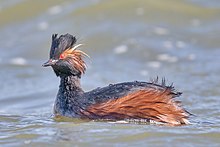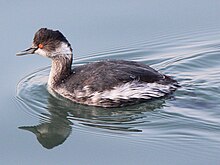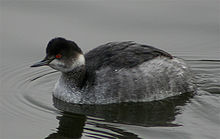Black-necked grebe
| Black-necked grebe | |
|---|---|

| |
| Subspecies nigricollis, adult breeding plumage | |

| |
| Subspecies nigricollis, adult non-breeding plumage | |
| Scientific classification | |
| Domain: | Eukaryota |
| Kingdom: | Animalia |
| Phylum: | Chordata |
| Class: | Aves |
| Order: | Podicipediformes |
| Family: | Podicipedidae |
| Genus: | Podiceps |
| Species: | P. nigricollis
|
| Binomial name | |
| Podiceps nigricollis Brehm, 1831
| |

| |
| Range of P. nigricollis Breeding Resident Passage Non-breeding
| |
The black-necked grebe or eared grebe (Podiceps nigricollis) is a member of the
The black-necked grebe uses multiple foraging techniques. Insects, which make up the majority of this bird's diet, are caught either on the surface of the water or when they are in flight; this species occasionally practices
Although it generally avoids flight, the black-necked grebe travels as far as 6,000 kilometres (3,700 mi) during
Taxonomy
This species was first described by Carl Ludwig Hablitz in 1783 as Colymbus caspicus, from a bird in Bandar-e Anzali. This was originally thought to be a synonym for the horned grebe, until Erwin Stresemann discovered that the description applied more to the black-necked grebe in 1948. Before this, the earliest description was thought to be by Christian Ludwig Brehm[2] in 1831, who gave this bird its current scientific name of Podiceps nigricollis[3] from a German bird. To resolve this, the International Commission on Zoological Nomenclature suppressed the name C. caspicus.[2] The genus name Dytes is sometimes used for this species,[4] a placement which was formalized by Robert Ridgway in 1881.[5]
This bird is closely related to the silvery grebe and the Junin grebe. The extinct Colombian grebe is sometimes considered to be a subspecies of this species, in addition to three other extant subspecies:[4]
- P. n. nigricollis – (Asia, and in eastern Africa[4]
- P. n. gurneyi – (Roberts, 1919): is found in southern Africa[4]
- P. n. californicus – (Heermann, 1854): is found from southwestern Canada through the western U.S. It winters as far south as Guatemala[4]
The generic name, Podiceps, comes from two Latin words: podicis, meaning 'vent' or 'anus', and pes meaning 'foot'.
"Black-necked grebe" has been designated the official name by the
Description

The black-necked grebe usually measures between 28 and 34 centimetres (11 and 13 in) in length and weighs 265 to 450 grams (9.3 to 15.9 oz). The bird has a wingspan range of 20.5–21.6 in (52–55 cm).
In non-breeding plumage, the nominate has greyish-black upper parts, cap, nape, and hindneck, with the colour on the upper portion of the latter being contained in a vertical stripe. The dark colour of the cap reaches below the eye and can be seen, diffused, to the ear-coverts. Behind the ear-coverts on the sides of the neck, there are white ovals. The rest of the neck is grey to brownish-grey in colour and has white that varies in amount. The breast is white, and the abdomen is whitish. The flanks are coloured in a mix of blackish-grey with white flecks. The colour of the bill when not breeding differs from that of the breeding plumage, with the former being significantly more grey.[4]

The juvenile black-necked grebe is similar to the non-breeding adult. There are differences, however, including the fact that the dark areas are usually more brownish in the juvenile, with less black. The lores are often tinged pale grey, with whitish marks behind the eye. On the sides of the head and upper neck, there is a buffy or tawny tinge. The chick is downy and has a blackish-grey head with stripes and spots that are white or pale buff-grey. The throat and foreneck are largely pale. The upper parts are mostly dark grey in colour, and the abdomen is white.[4]
The subspecies californicus usually has a longer bill compared to the nominate, and has brown-grey inner primaries during the breeding season. When not breeding, the nominate has diffuse and pale lores less often than Podiceps nigricollis californicus. The other subspecies, P. n. gurneyi, is the smallest of the three subspecies, in addition to having a greyer head and upper parts. The adult of this subspecies also has a rufous-brown tinge on its lesser wing-coverts. It also lacks a non-breeding plumage, in addition to the tufts on the side of its head being paler.[4]
Vocalizations
When breeding, the black-necked grebe gives a quiet "ooeek"[needs IPA] that ascends in pitch from an already high pitch. This call is also used as a territorial call, in addition to a low and fast trill, which itself is also used during courtship. Another call is a short "puuii" or "wit".[needs IPA] This grebe is silent when it is not the breeding season[4] and when it is feeding or resting.[14]
Distribution and habitat
This species breeds in vegetated areas of freshwater
Behaviour
This grebe is highly
Breeding
This species builds its floating nest in the usually shallow water of open lakes.

Pair formation in the black-necked grebe usually starts during pauses in the migration to the breeding grounds, although it occasionally occurs before, in wintering pairs. This pair formation continues after this grebe has arrived to its breeding grounds.[11] Courtship occurs when it arrives at the breeding lake. The displays are performed in the middle of the lake. There is no territory involved in courting; individuals use the whole area of the lake. When advertising for a mate, a black-necked grebe will approach others of its species with its body fluffed out and its neck erect. It closes its beak to perform a call, poo-eee-chk, with the last note only barely audible. Courtship generally stops at the start of nesting.[24]
In the Northern Hemisphere, this bird breeds from April to August. In east Africa, the breeding season is at least from January to February, while in southern Africa, the breeding season is from October to April.[4]
The black-necked grebe is
This grebe lays a clutch, sometimes two,[4] of three to four chalky greenish or bluish eggs.[21] Nests that have been parasitized, however, will have two more eggs on average, even though the number the host lays is about the same no matter if it has been parasitized or not.[22] The eggs, although initially immaculate, do get stained by plant matter that the nest is built out of. The eggs measure 45 by 30 millimetres (1.8 by 1.2 in) on average and are incubated by both parents for about 21 days.[21] The laying date of the eggs is somewhat synchronized, with birds in small colonies having the laying dates spread out by just a few days, compared to large colonies, where the laying date is spread out over more than 10 days.[24]
After the chicks hatch, the birds will desert their nest.[21] Even though the young can swim and dive during this time, they rarely do, instead staying on the parents' backs for four days after hatching.[14] This behaviour is present in all grebes, and is likely to have evolved because it reduces travel costs, specifically those back to the nest to brood the chicks and give them food.[25] After about 10 days, the parents split the chicks up, with each parent taking care of about half of the brood.[21] After this split, the chicks are independent in about 10 days,[4] and fledge in about three weeks.[21]
When disturbed while incubating, this bird usually (just under 50% of the time) partly covers its eggs with nest material when the disruption is not sudden, but a bird with an incomplete clutch usually does not attempt to cover the eggs. When the disruption is sudden, on the other hand, the black-necked grebe usually (just under 50% of the time) does not cover its eggs. In comparison, other species of grebes cover up their eggs when leaving the nest.[26] Predation is usually not the primary cause of egg loss, with most nesting failures occurring after the chicks have hatched. A major cause of this is the chilling of the young.[14]
Feeding
The black-necked grebe forages mainly by diving[4] from the water,[14] with dives usually lasting less than 30 seconds.[4] These dives are usually shorter in time when in more shallow water.[27] In between dives, this grebe rests for an average of 15 seconds.[28] When feeding on brine shrimp at hypersaline lakes, it likely uses its large tongue to block the oral cavity. It is hypothesized that it then crushes prey against its palate to remove excess water.[29] It also forages by gleaning foliage, plucking objects off of the surface of water, having its head submerged while swimming, and sometimes capturing flying insects.[4]
This grebe eats mostly insects, of both adult and
The young are fed one at a time by the parents, with one bird carrying the young while the other feeds it. The young take food by grabbing it, with their beaks, from their parents, or by grabbing food dropped into the water. When a young bird cannot grab the food, then the adults submerge their bill into the water and shake their bill to break up the food.[14]
Moult and migration
When breeding is over, some black-necked grebes moult while still on the breeding grounds, but most do so only after a moult migration.[31] This migration is to saline lakes, especially lakes with large numbers of invertebrate prey, so that birds can fatten up while moulting before continuing on the winter migration.[32] The moult migration is dangerous, with hundreds and sometimes thousands of birds being killed by snowstorms when traveling to places such as Mono Lake.[33]
After the moult migration, birds moult their remiges between August and September,[34] which makes them unable to fly. The moult is preceded by an increase in weight. During the moult, the breast muscles atrophy. When the moult is completed, birds continue to gain weight, often more than doubling their original weight.[32] This additional fat is used to power the black-necked grebe's overnight fall migration to its wintering grounds. The fat is most concentrated in the abdomen, second most in the thorax, and least in the chest.[35] Migration usually starts earlier when shrimp are more abundant and when the moulting lake is at a higher than average temperature. Birds generally leave on a clear night with lower than average surface temperatures.[36]
Movement

This grebe is one of the most inefficient fliers among birds. Generally, it avoids flying at all costs and reserves long-distance flight exclusively for migration.[37] This is combined with the fact that this bird is flightless for 35–40 days during its moult.[32] However, when migrating, it travels as much as 6,000 kilometres (3,700 miles) to reach rich feeding areas that are exploited by few other species.[37] In flight, the shape of this grebe is like a loon: straight neck, legs trailing, and wings beating often.[14]
When diving, this bird pulls its head back and then arches it forward into the water, with the body following and a slight springing. The legs start moving only after they are underwater. When swimming on the surface of the water, the body of this grebe is relatively high, although none of the underparts are seen. The neck is held straight up in a relaxed manner, with the bill being held forward and parallel to the water. Each of the feet perform strong alternating strokes.[14]
Disease
Large-scale deaths (such as 150,000 birds on the Salton Sea in 1992) from
Status
As of 2016, the black-necked grebe is classified as least concern by the International Union for Conservation of Nature (IUCN). The trend of the population is uncertain, as some populations are decreasing, whereas others are stable, have an uncertain trend, or are increasing. The justification for the current classification of this species is its very large population (estimated around 3.9–4.2 million individuals) combined with a large estimated extent of occurrence (about 155 million km2 (60 million sq mi)).[1] This grebe is probably the most numerous grebe in the world.[4]
Unknown
References
- ^ . Retrieved 19 November 2021.
- ^ a b Mlíkovský, Jiří. "Types of the Podicipedidae". British Ornithologists' Club Occasional Publications. 5: 132–136.
- ^ Brehm, Christian Ludwig (1831). Handbuch der Naturgeschichte aller Vögel Deutschlands: worin nach den sorgfältigsten Untersuchungen und den genauesten Beobachtungen mehr als 900 einheimische Vögel-Gattungen ... beschrieben sind : mit 47 ... nach der Natur gezeichneten illuminirten Kupfertafeln (in German). B.F. Voigt. p. 963.
- ^ S2CID 216319901. Retrieved 28 June 2017.
- ISBN 9780665056529.
- ^ Ogilvie & Rose (2003), p. 98.
- ISBN 978-1-4081-2501-4.
- ^ Jobling, James A. del Hoyo, Josep; Elliott, Andrew; Sargatal, Jordi; Christie, David A.; de Juana, Eduardo (eds.). "Key to Scientific Names in Ornithology". Handbook of the Birds of the World Alive. Barcelona: Lynx Edicions. Retrieved 7 August 2017.
- ^ Gill, Frank; Donsker, David, eds. (2017). "Grebes, flamingos & tropicbirds". World Bird List Version 7.3. International Ornithologists' Union. Retrieved 26 September 2017.
- ^ Ogilvie & Rose (2003), pp. 102–103.
- ^ ISBN 0-19-854099-X.
- ^ "Eared Grebe Identification, All About Birds, Cornell Lab of Ornithology". www.allaboutbirds.org. Retrieved 26 September 2020.
- ISBN 978-0-06-112040-4.
- ^ a b c d e f g McAllister, Nancy Mahoney (1955). Reproductive behaviour of the eared grebe, Podiceps caspicus nigricollis (Master of Arts). University of British Columbia.
- ^ Herrera, Néstor; Rivera, Roberto; Ibarra Portillo, Ricardo; Rodríguez, Wilfredo (2006). "Nuevos registros para la avifauna de El Salvador" [New records for the avifauna of El Salvador] (PDF). Boletín de la Sociedad Antioqueña de Ornitología (in Spanish and English). 16 (2): 1–19.
- S2CID 86278773.
- ^ S2CID 216319901. Retrieved 9 October 2017.
- ISBN 978-0-679-42852-7.
- ^ a b Faaborg, John. "Habitat selection and territorial behavior of the small grebes of North Dakota". The Wilson Bulletin. 88 (3): 390–399.
- ^ .
- ^ ISBN 978-0-226-05781-1.
- ^ JSTOR 3677228.
- .
- ^ JSTOR 4081975.
- PMID 29178481.
- ^ Broekhuysen, G. J.; Frost, P. C. H. (1968). "Nesting hehaviour of the black-necked grebe Podiceps nigricollis (Brehm) in Southern Africa. I. The reaction of disturbed incubating birds". Bonner zoologische Beiträge. 19 (3): 350–361.
- ^ Ladhams, D. E. (1968). "Diving times of grebes". British Birds. 61 (1): 27–30.
- S2CID 84709752.
- JSTOR 1367221.
- S2CID 25620897.
- JSTOR 4087994.
- ^ ISBN 0-935868-39-9.
- JSTOR 4089464.
- ISSN 0019-1019.
- ISSN 0908-8857.
- S2CID 90800779.
- ^ ISBN 978-3-642-07780-7.
- ^ JSTOR 4514141.
- ^ PMID 24761310.
- PMID 28500043.
Bibliography
- Ogilvie, Malcolm; Rose, Chris (2003). Grebes of the World. Uxbridge, UK: Bruce Coleman. ISBN 1-872842-03-8.
External links
- Explore Species: Black-necked Grebe at eBird (Cornell Lab of Ornithology)

